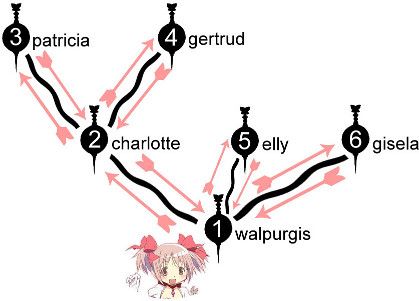HDU 4041 Eliminate Witches! (模拟题 ACM ICPC 2011亚洲北京赛区网络赛)
HDU 4041 Eliminate Witches! (模拟题 ACM ICPC 2011 亚洲北京赛区网络赛题目)
Eliminate Witches!
Time Limit: 2000/1000 MS (Java/Others) Memory Limit: 32768/32768 K (Java/Others)
Total Submission(s): 863 Accepted Submission(s): 342
One day Madoka is eliminating Witches as usual. This time she is facing a maze full of Witches. The maze consists of rooms, each lives exactly one Witch. And there is exactly one path from one room to another. So you see, the maze can be represented as a tree, with rooms regarded as nodes on the tree.
Madoka eliminates Witches according to the following rules:
1. At first, Madoka enters the root node room of the maze.
2. If the room Madoka enters lives a Witch, Madoka will eliminate it at once, and the Witch disappear.
3. If the room has child node rooms with Witches, Madoka will choose the leftmost one and enter it.
4. Madoka won't go back to the parent node room of a room X until Witches living in child node rooms of X are all eliminated.
See the figure below for details about a sample maze. The numbers inside nodes indicate the order of elimination of the corresponding Witches, the strings below nodes are names of Witches, and the arrow shows the tracks Madoka travels:

After finishes her task, Madoka just make a brief log like this:
"walpurgis(charlotte(patricia,gertrud),elly,gisela)"
which represents the tree-like maze identifying rooms by the names of Witches living in them.
Akemi Homura, a classmate of Madoka, also a Magical Girl, is a mad fan of her. She wants to take detailed notes of everything Madoka do! Apparently the log Madoka made is hard to read, so Homura decide to make a new one of her own.
The new log should contain the following information:
1. The number of rooms of the maze
2. Names of Witches in all rooms.
3. The tracks Madoka travels. (represented by the number identifying the node)
So the new log should be like this:
6
walpurgis
charlotte
patricia
gertrud
elly
gisela
1 2
2 3
3 2
2 4
4 2
2 1
1 5
5 1
1 6
6 1
However, the maze may be very large, so Homura nees a program to help her.
For each case there is only one string on a line, Madoka's log.
It is guaranteed that the maze consists of at most 50000 rooms, and the names of Witches is a string consists of at most 10 lowercase characters, while the string of Madoka's log consists of at most 1000000 characters, which are lowercase characters, '(', ')' or ','.
The first line an integer N, the number of rooms of the maze.
The following N lines, each line a string, the name of the Witches, in the order of elimination.
The following 2(N-1) lines, each line two integers, the number of two nodes indicating the path Madoka passes.
Output a blank line after each case.
#include <iostream>
#include <cstring>
#include <cstdio>
#include <string>
#include <map>
#include <cstring>
#include <vector>
using namespace std;
const int maxlen=10000010;
vector <string> ans;
vector <int> v;
map <string,int> mp;
char str[maxlen];
int len,num,pos;
void initial(){
ans.clear();
mp.clear();
v.clear();
num=1;
pos=0;
}
void input(){
scanf("%s",str);
len=strlen(str);
}
void dfs(){
if(pos>=len) return;
string st;
while(str[pos]>='a' && str[pos]<= 'z'){
st.push_back(str[pos]);
pos++;
}
ans.push_back(st);
int now=num++;
v.push_back(now);
if(str[pos]=='('){
pos++;
dfs();
v.push_back(now);
while(str[pos]==','){
pos++;
dfs();
v.push_back(now);
}
pos++;
}else return;
}
void computing(){
dfs();
}
void output(){
printf("%d\n",num-1);
for(int i=0;i<ans.size();i++){
printf("%s\n",ans[i].c_str());
}
for(int i=0;i<v.size()-1;i++){
printf("%d %d\n",v[i],v[i+1]);
}
printf("\n");
}
int main(){
int t;
cin>>t;
while(t-- >0){
initial();
input();
computing();
output();
}
return 0;
}
1)前序遍历
a)递归方式:
void preorder_recursive(Bitree T) /* 先序遍历二叉树的递归算法 */
{
if (T) {
visit(T); /* 访问当前结点 */
preorder_recursive(T->lchild); /* 访问左子树 */
preorder_recursive(T->rchild); /* 访问右子树 */
}
}
b)非递归方式
void preorder_nonrecursive(Bitree T) /* 先序遍历二叉树的非递归算法 */
{
initstack(S);
push(S,T); /* 根指针进栈 */
while(!stackempty(S)) {
while(gettop(S,p)&&p) { /* 向左走到尽头 */
visit(p); /* 每向前走一步都访问当前结点 */
push(S,p->lchild);
}
pop(S,p);
if(!stackempty(S)) { /* 向右走一步 */
pop(S,p);
push(S,p->rchild);
}
}
}
2)中序遍历
a)递归方式
void inorder_recursive(Bitree T) /* 中序遍历二叉树的递归算法 */
{
if (T) {
inorder_recursive(T->lchild); /* 访问左子树 */
visit(T); /* 访问当前结点 */
inorder_recursive(T->rchild); /* 访问右子树 */
}
}
b)非递归方式
void inorder_nonrecursive(Bitree T)
{
initstack(S); /* 初始化栈 */
push(S, T); /* 根指针入栈 */
while (!stackempty(S)) {
while (gettop(S, p) && p) /* 向左走到尽头 */
push(S, p->lchild);
pop(S, p); /* 空指针退栈 */
if (!stackempty(S)) {
pop(S, p);
visit(p); /* 访问当前结点 */
push(S, p->rchild); /* 向右走一步 */
}
}
}
3)后序遍历
a)递归方式
void postorder_recursive(Bitree T) /* 中序遍历二叉树的递归算法 */
{
if (T) {
postorder_recursive(T->lchild); /* 访问左子树 */
postorder_recursive(T->rchild); /* 访问右子树 */
visit(T); /* 访问当前结点 */
}
}
b)非递归方式
typedef struct {
BTNode* ptr;
enum {0,1,2} mark;
} PMType; /* 有mark域的结点指针类型 */
void postorder_nonrecursive(BiTree T) /*
后续遍历二叉树的非递归算法 */
{
PMType a;
initstack(S); /* S的元素为PMType类型 */
push (S,{T,0}); /* 根结点入栈 */
while(!stackempty(S)) {
pop(S,a);
switch(a.mark)
{
case 0:
push(S,{a.ptr,1}); /* 修改mark域 */
if(a.ptr->lchild)
push(S,{a.ptr->lchild,0}); /* 访问左子树 */
break;
case 1:
push(S,{a.ptr,2}); /* 修改mark域 */
if(a.ptr->rchild)
push(S,{a.ptr->rchild,0}); /* 访问右子树 */
break;
case 2:
visit(a.ptr); /* 访问结点 */
}
}
}